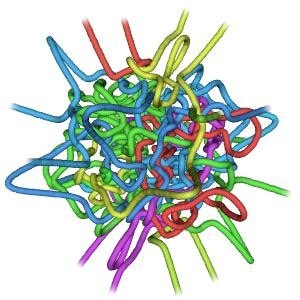Aug 1 2016
According to a new study, three-dimensional (3D) tangled vortex filaments can be knotted in many different ways using wave chaos computer models.
 Tangled quantum vortices. Each vortex line is shaded in a different color, and may be knotted or linked with the others (image credit: School of Physics © University of Bristol)
Tangled quantum vortices. Each vortex line is shaded in a different color, and may be knotted or linked with the others (image credit: School of Physics © University of Bristol)
Academics at the University of Bristol performed computer experiments, which led to many highly complex knots. Pure mathematicians dedicated to the realm of knot theory have now documented these various complex knotted structures.
Humans are always surrounded by waves. For example, light waves help us to see, the noise around us contains sound waves, and even matter contains a wave nature according to quantum mechanics. However, almost all these waves have a highly chaotic pattern and differ from the typical chain of waves at the ocean shore.
The most interesting fact is that eddies and whirls create lines in space which are referred to as vortices. The wave intensity along these lines is zero, and natural wave fields such as sound, light, and quantum matter are packed with a thick knot of these null filaments.
Although the computer models were framed in the language of quantum waves, these results are expected to be completely general, suggesting a new understanding of the complexity of the three-dimensional optical and acoustic landscapes that surround us every day.
Mark Dennis, Professor of Theoretical Physics in the School of Physics
Over four decades ago, Bristol physicians Professor John Nye and Professor Sir Michael Berry found that vortices were initially considered to be a major component of wave phenomena.
The study has been reported in in Nature Communications and was supported by the Leverhulme Trust.
The research is part of the Scientific Properties of Complex Knots (SPOCK) project, a partnership between the Universities of Bristol and Durham.
The project aims to develop novel mathematical methods and computational tools for the research, production, and utilization of knotted structures in many different complex physical phenomena.